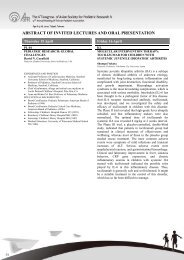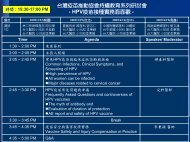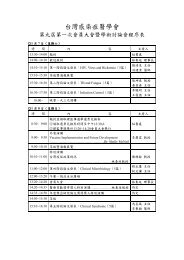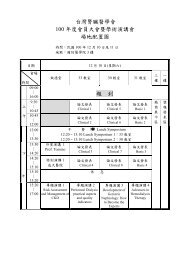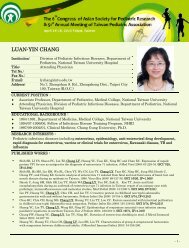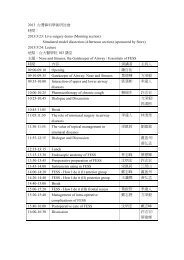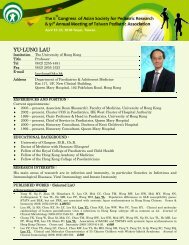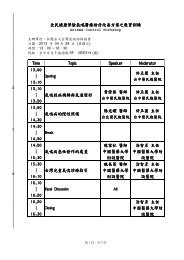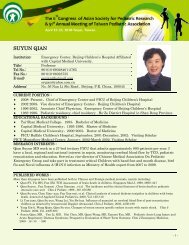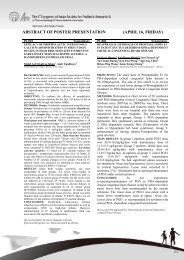ABSTRACT OF POSTER PRESENTATION (APRIL 17, SATURDAY)
ABSTRACT OF POSTER PRESENTATION (APRIL 17, SATURDAY)
ABSTRACT OF POSTER PRESENTATION (APRIL 17, SATURDAY)
You also want an ePaper? Increase the reach of your titles
YUMPU automatically turns print PDFs into web optimized ePapers that Google loves.
P2-055 Neuropsychiatry (Neurology) P2-056 Neuropsychiatry (Neurology)THE RELATIONSHIP <strong>OF</strong> THE RISK FACTORAND THE PROGNOSIS <strong>OF</strong> AGENESIS <strong>OF</strong>INFLUENZA B ENCEPHALITIS WITH UNCALHERNIATION: A CASE REPORTCORPUS CALLOSUMYun-Hsuan Yang , Huei-Shyong Wang, Kuang-Lin Lin,Po-Cheng Hung, Min-Liang Chou, Meng-Ying Hsieh,Reyinl LienDepartment of Pediatric, Chang Gung Memorial Hospital, Lin-Ko, TaiwanOBJECTIVES: Agenesis of the corpus callosum (ACC) consistsof a heterogeneous group of disorders that vary in expression fromsevere intellectual and neurologic abnormalities to theasymptomatic and normally intelligent individual. When agenesisof the corpus callosum is an isolated phenomenon, the patient maybe normal, whereas individuals with neurologic symptoms,including mental retardation, microcephaly, hemiparesis, diplegia,and seizures, have associated brain anomalies due to cellmigration defects, such as heterotopias, microgyria, andpachygyria in addition to the absence of the corpus callosum.Prognosis of ACC depends on the extent and severity ofmalformations. ACC does not cause death in the majority ofchildren. Mental retardation does not worsen. Although manychildren with the disorder have average intelligence and leadnormal lives, neuropsychological testing reveals subtle differencesin higher cortical function compared to individuals of the sameage and education without ACC. Our aim is to study therelationship of the risk factor and the prognosis of ACC.METHODS: We retrospectively reviewed the patients diagnosedof ACC in Chang Gung Children’s Hospital. The case number was49 and the following duration was from 1999 April to 2009 atpresent. Clinical histories were reviewed including birth history,admission course, genetic analysis, image study and outpatientfollow up. Risk factors evaluated including age, sex, birthcondition (preterm/term, NSD/CS, AS), ACCpattern(isolated/combined with other malformations), time ofdiagnosis, EEG pattern, congenital anomaly and maternalcondition. We use Glasgow Outcome Scale to evaluate theprognosis of the patient.MAIN RESULTS: There were 24 male and 25 female patientsand average age was 7-year-6-month old (11-month-old to11-year-1-month old). 27 patients were fullterm and 9 wherepreterm babies when birth (13 patients had no birth data). 5patients were diagnosed by prenatal sonography and 44 patientswere diagnosed after birth by brain echo, brain MRI or brain CT.30 patient were isolated ACC and other 19 patients were ACCwith other malformations. Only one patient was partial ACC and15 patients were complete ACC confirmed by brain MRI or brainCT. 33 patients received EEG study and 7 patients were normalwhereas other 26 patients had cortical dysfunction or epileptiformdischarge. 19 patients had congenital anomaly. We evaluated 32patients by Glasgow Outcome Scale and 16 patients were higherthan score 3 whereas 16 patients were lower than score 4. Wefound that Apgar score and congenital anomaly had relationshipwith prognosis of ACC (95% CI 1.205-13.283 P=0.010; 95% CI0.014-0.499, P=0.005).CONCLUSION: Although prognosis of agenesis of corpuscallosum depends on the extent and severity of malformations, wefound that Apgar score and congenital anomaly also havecorrelation with prognosis. However, the further clinicalpresentation and treatment effect still need to be studied in thefuture.Zheng-Nan Chin 1 , Yu-Tzu Chang 1 , I-Ching Chou 1 *,Sung-Hsi Wei 3 , Huang-Tsung Kuo 2 and Chang-Hai Tsai 11 Division of Pediatric Neurology, Children’s Medical Center, China MedicalUniversity Hospital, Taichung, Taiwan; 2 Division of Development and BehaviorPediatrics, China Medical University Hospital, Taichung, Taiwan; 3 TaiwanCenters for Disease Control, TaiwanOBJECTIVE: Influenza A and B viruses primarily cause aself-limited upper respiratory tract infection. Complicationsfrom influenza A or B virus infection include pneumonia,myositis, myocarditis, and encephalitis. Although encephalitishas been associated with both influenza A and B virusinfection, this complication appears to be less frequent withtype B infections. We reported a case of influenza Bencephalitis associated (IBAE) who was characterized by rapidonset of neurologic sign and progressed to death, and severebrain edema with uncal herniation.METHODS: A 9 years old Taiwanese female presented withfever, dizziness, myalgia, decreased in appetite and cough for 2days. Six hours prior to admission, high fever up to 40.5℃,conscious disturbance, eye upward gaze, and flaccid withoutcyanosis were noted. Four hours later, generalized seizureattack again for 5 minutes. Physical examination found flaccidand comatose girl with bilateral pupil dilatation and withabsence of light reflex. Mild retinal hemorrhage andpapilledema was found by funduscopy.MAIN RESULTS: Cerebrospinal fluid analysis revealed nopleocytosis but elevated protein. Brain CT, performed 11 hoursafter seizure attack, revealed diffused brain edema with uncalherniation. This image finding was rarely reported in previousmedical literature. Patient expired 29 hours after admissionbecause of multi-organ failure.CONCLUSION: In our review, majority of the influenza Bassociated encephalitis (IBAE) cases fully recovered butminority of them suffered from neurologic sequela or evendeath. The image findings (CT or MRI) were consisted withvarious characteristics, which included normal findings,normal findings in the acute phase followed by mild brainatrophy, diffuse cortical necrosis, symmetric thalamic lesions,and diffused brain edema in acute phase followed by normalfindings. In Taiwan, an unpublished data from Centers ofDisease Control, Taiwan reported 8 patients had evidence ofinfluenza B infection, included our case. Two patients hadcommon characteristics of brain edema but only our patienthad uncal herniation. Influenza B associated encephalitis(IBAE) has very low worldwide prevalence. The manifestationof rapid deterioration brain edema to uncal herniation is evenrarer. Clinical physician should be aware of this fatalcomplication.[Keywords] Influenza B, encephalitis, brain edema[Keywords]Agenesis of corpus callosum, risk factor, prognosis282



